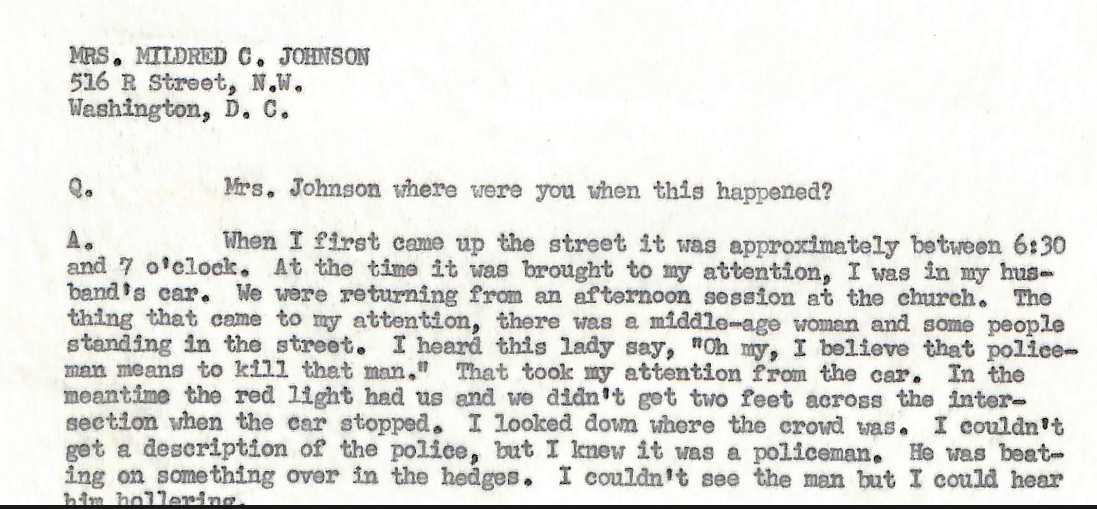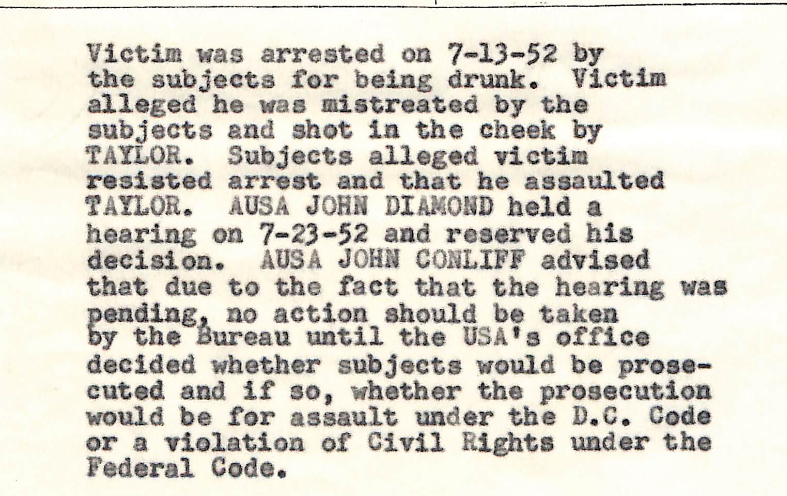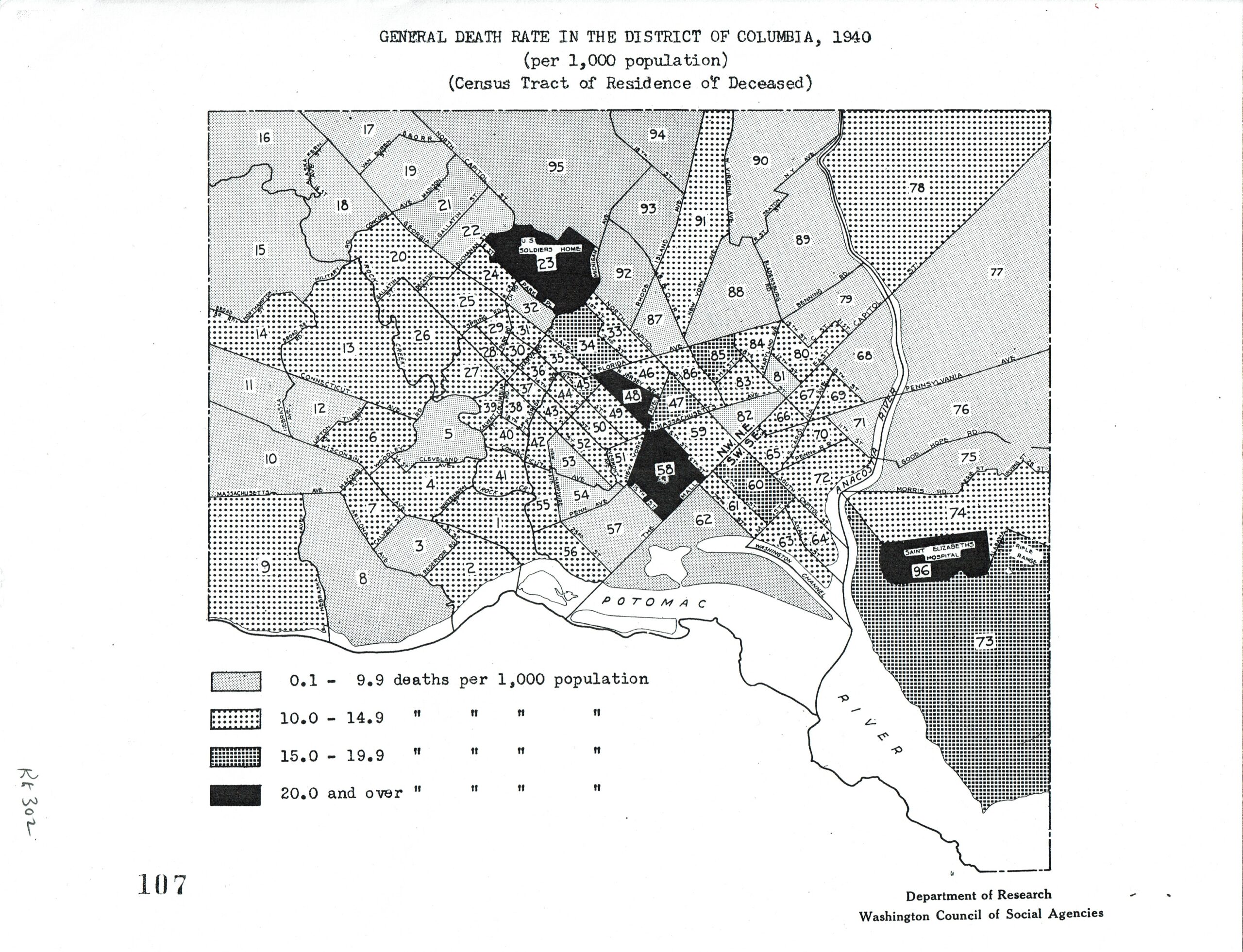If it is 1940 and you’re living between 7th and New Jersey, your days were numbered.
Tag: History
It happened on the 600 block of Rhode Island in 1952, part 8 of many
This is the second look at 144-16-95 [Frank Ray, Melvin Clements; Loran Lovan Taylor, Roland L. Gay – Victims] for information about an incident that happened around the 600 block of Rhode Island Avenue in 1952.
We’ll skip over a few witnesses. If you want to read their testimony go to the link above for DOJ file 144-16-95.
I’m picking Buster Key of 1715 1/2 7th St NW because he seems to be one of the less than reliable witnesses.
BUSTER KEY, 1715 1/2 7th Street, N. W., was interviewed on October 29, 1952 in Marion Court and advised that he has know the victim for several years and had seen him on numerous occasions in Marion Court. He stated that on July 13, 1952, he was visiting in the Court and at approximately 9:00 AM, he had noticed ZEKE in the Court. He pointed out that at the time ZEKE was not drunk and had come to a point where he, BUSTER, was standing and had given him a drink of wine from a quart bottle. BUSTER stated that he later left the alley and returned sometime in the late afternoon, at which time he noticed that ZEKE was sitting in a doorway on the west side of the alley at approximately 1721 Marion Court. He explained that when the police officers came into the alley, he was standing at a position opposite to ZEKE across the alley and that he had seen the police officers take ZEKE by his arms and walk him down the alley in the direction of “R” Street, N.W. KEY stated that at no time while victim and police officers were in the alley did he see any fighting or scuffling and that ZEKE was not hit by either of the officers during the period that he was in their custody, in Marion Court.
Continue reading It happened on the 600 block of Rhode Island in 1952, part 8 of many
1968 Map and Key
It happened on the 600 block of Rhode Island in 1952, part 7 of many- Smoke Drinkers
This is the second look at 144-16-95 [Frank Ray, Melvin Clements; Loran Lovan Taylor, Roland L. Gay – Victims] for information about an incident that happened around the 600 block of Rhode Island Avenue in 1952.
In part 6 I had the testimony of Frances Bernice Smith. There was a little something extra after her signed statement. The smoke drinkers were the crack heads of the 1950s.
FRANCES SMITH advised that near the point where ZEKE was sitting when the police officers arrest im numerous “smoke drinkers” congregate. She stated that these individuals always built a fire and for all purposes lived sleeping on the spot both in rain and snow. She stated that these individuals, whom she referred to as “smoke drinkers”were people who had no fixed address and who spent their day drinking a mixture of paint remover and water which they shook in a coca cola bottle until it turned into a milky white substance. She advised that they then drink this liquid and always appear to be under the influence of this concoction.
FRANCES SMITH commented that through instinct these individuals, if they are able to navigate, would disappear around the block at the first sight of a police officer entering Glicks Alley. She added they no sooner would the officers be out of sight before these “smoke drinkers” would be in the alley.
FRANCES SMITH pointed out that on the day in question these individuals had disappeared when the police officers first came in the alley and that none of them would have seen anything which had transpired.
FRANCES SMITH further advised that she had seen ZEKE drunk on many occasions in Glicks Alley, that he was in her opinion a “smoke drinker”, and for all purposes was what was known as a “lush”, She explained that a person who got drunk and either locked up or went and layed down and slept his intoxication off . She pointed out
that he was not the type individual who became mean and nasty when intoxicated and that she had never seen him in a fight or possessing any type of a weapon.
FRANCES SMITH commented that the following individuals resided at 1707 Marion Court, NW:
AUDREY WESTER,
EDITH JOHNSON,
SAMUEL BURTON,
THOMAS CHRISTMAN.
These people were contacted and advised that they had not been present in the alley on the day that the victim was arrested.
It happened on the 600 block of Rhode Island in 1952, part 6 of many
This is the second look at 144-16-95 [Frank Ray, Melvin Clements; Loran Lovan Taylor, Roland L. Gay – Victims] for information about an incident that happened around the 600 block of Rhode Island Avenue in 1952.
I’d been looking at the interviews fresh from the scene, however, I’m going to move to the final report that has all the interviews typed up. Reading cursive handwriting is too taxing.
 So I’ll start with Mrs. Frances Smith who lived at 1707 Marion Ct/ Glicks Alley… which sort of no longer exists. She mention’s “Daddy Grace’s fence” this is the rear of the UHOP on the 1700 block of 7th St NW. Her words: Continue reading It happened on the 600 block of Rhode Island in 1952, part 6 of many
So I’ll start with Mrs. Frances Smith who lived at 1707 Marion Ct/ Glicks Alley… which sort of no longer exists. She mention’s “Daddy Grace’s fence” this is the rear of the UHOP on the 1700 block of 7th St NW. Her words: Continue reading It happened on the 600 block of Rhode Island in 1952, part 6 of many
It happened on the 600 block of Rhode Island in 1952, part 5 of many
This is the second look at 144-16-95 [Frank Ray, Melvin Clements; Loran Lovan Taylor, Roland L. Gay – Victims] for information about an incident that happened around the 600 block of Rhode Island Avenue in 1952.
The next statement comes from Frank E. Pinckney of 604 R St NW. The image is from a statement that someone wrote in cursive. The statement below that is from a report that compiled all of the witness statements. The two are slightly different.
From pp.94-96 of FBI 44-WFO-145, pp. 112-114 of DOJ 144-16-95:
“On Sunday, July 13, 1952, at about 6:30 p.m. I was sitting on the front steps of my residence at 604 R Street, N. W. There was no one else home at the time. My attention was attracted to the north side of R Street by loud talking and shouting. I looked up and at the west end of the hedge or the south side of the park I observed two white police officers with a colored prisoner. The officers were surrounded by about fifteen or twenty people. The people were shouting and hollering at the police officers and I thought that a riot was about to start as the people were crowding in on the officers and I didn’t know what might happen. I recall there were about six or eight cars parked on the north side of R Street.
I did not see any motorcycle parked. There were no cars parked on the south side of R Street, N. W. There were a few cars moving along R Street and some of them stopped and made the crowd larger.
The police officers each had a hold of an arm of the man and the man was between them. Because of the crowd and the cars my view was somewhat obstructed. The man was not walking but was being dragged along by the officers with his feet scraping along the ground. The man was pulling and twisting around and kicking out with his feet at the officers. They appeared to be having considerable trouble making their way along the sidewalk with the man. The police officers did not hit the man up to this time and were very busy trying to drag him along.
I do not know if the crowd touched the officers as I could
not see clearly because of the cars but the crowd was shouting abuse at the officers.
The officers continued struggling along with the man until they got just opposite my house between the second and third tree on the north side of R Street. At this point the man slumped down on the sidewalk. The police officers tried to get the man to stand up. The man was twisting and rolling around on the ground and kicking at the officers. The officers were struggling with him trying to get him to his feet, but could not get the man up. Because of the crowd and cars I could not tell whether any of the man’s kicks touched the officers, however, they were very close to the man and were wrestling with him and were rolling around on the sidewalk with him. Just at this point the man appeared to be getting out of
control entirely. One of the police officers, I didn’t know which one, then grabbed his night stick and struck at the man. I could not see where the blows struck the man but I could hear the man shouting “Don’t hit me anymore, don’t hit me anymore.” I estimate that the police officer struck only about three blows at the man. The other police officer did not strike at the man at all, he was engaged in trying to hold on to the man.
At this point my phone rang and I went into the house. I talked briefly on the phone to my brother, WARREN B. PICKNEY, of 428 Galt Street, N.E. I did not mention to him what was going on outside. While talking on the phone I heard one shot. I continued talking for a brief period and then when finished I came back out on my front steps. Just as I got outside on my steps again the patrol wagon got on the scene. There were then four officers present and a large crowd of 100 or more had gathered and people and cars were arriving from every direction. Because of the crowd I could not see the man. I continued to watch until the ambulance came and took the man away.
I would like to say that when I first saw the man he did not appear to have any blood on him or to be injured in any way. I could not see the man as he was being struck by the police officer. When the man was put in the ambulance I could see blood on his head. I could not see the man well enough at any time to tell if he had anything in his hands.
I would like to add that just before my phone rang one of the two officers ran to the call box at 6th and R Streets, N. W. I would not be able to identify either officer or the man if I were to see them again.
I did not notice if either officer had any blood or marks on, Him.
This statement was read to me as I forgot my glasses. It is true.
It happened on the 600 block of Rhode Island in 1952, part 4 of many
This is the second look at 144-16-95 [Frank Ray, Melvin Clements; Loran Lovan Taylor, Roland L. Gay – Victims] for information about an incident that happened around the 600 block of Rhode Island Avenue in 1952.
The next statement comes from Annie Gardner of 614 R St NW. I will do my best transcription.
“saw situation when officer shot man said he was lying on sidewalk when I first saw them they were in front of the lamppost dragging him along beating one went for the patrol wagon and one continued to beat while he was lying on the groung [sic] helpless. The officer fired three shots.”
It happened on the 600 block of Rhode Island in 1952, part 3 of many
This is the second look at 144-16-95 [Frank Ray, Melvin Clements; Loran Lovan Taylor, Roland L. Gay – Victims] for information about an incident that happened around the 600 block of Rhode Island Avenue in 1952. Last we had Mrs. Mildred Johnson of 516 R St NW, statement. This post has her husband, Mr. Travanyon Johnson . He doesn’t add much.
STATEMENT
TRAVANYON JOHNSON
516 R Street, N.W.
Washington, D. C.

I saw the same thing my wife saw, and the man did not
have a knife. If he had one he couldn’t get to it anyway. If the officer had been cut, you could have seen the blood on him, and I saw no knife. The officers shirt was not torn. The man had no power of any kind to do anything to the officers.
Travanyon Johnson
***
I don’t know why the statement about the knife was removed. I know that the prospect of Zeke having a knife and cutting one of the police officers comes up later in the file.
It happened on the 600 block of Rhode Island in 1952, part 2 of many
This is the second look at 144-16-95 [Frank Ray, Melvin Clements; Loran Lovan Taylor, Roland L. Gay – Victims] for information about an incident that happened around the 600 block of Rhode Island Avenue.
Today we will look at a statement from Mrs. Mildred C. Johnson who lived at 516 R St NW.
STATEMENT
MRS. MILDRED C. JOHNSON
516 R Street, N.W.
Washington, D. C.
Q.
Mrs. Johnson where were you when this happened?
A.
When I first came up the street it was approximately between 6:30
and 7 o’clock. At the time it was brought to my attention, I was in my husband’s car. We were returning from an afternoon session at the church. The thing that came to my attention, there was a middle-age woman and some people standing in the street. I heard this lady say, “Oh my, I believe that policeman means to kill that man.” That took my attention from the car. In the meantime the red light had us and we didn’t get two feet across the intersection when the car stopped. I looked down where the crowd was. I couldn’t
get a description of the police, but I knew it was a policeman. He was beating on something over in the hedges. I couldn’t see the man but I could hear him hollering.

Q.
How many times did this police officer strike this man?
A.
I don’t know because this was going on before my attention was
called to it. He must have struck him 3 or 4 times when I noticed it. At this time the billie broke in half. At that time it seems the man might have tried to get to his feet. No sooner than the billie was broken the policeman went in his holster and went bang, bang, bang.
It happened on the 600 block of Rhode Island in 1952, part 1 of many
There is a huge file from the Department of Justice about an incident that occurred around the 600 block of Rhode Island Avenue NW in the early 1950s.
The file we’ll be looking at is 144-16-95 [Frank Ray, Melvin Clements; Loran Lovan Taylor, Roland L. Gay – Victims] and you can look at this 240 page thing on the National Archives Catalog.
The investigation is mainly about a guy named Ezekiel “Zeke” Seigler, whose civil rights may have been violated when he was beaten by MPD. I’m going to spoil the ending. Nothing happens.
Seigler was an alcoholic who didn’t remember the beating. He made for a crap witness so therefore, nothing happened. But that’s not the interesting part. The interesting part is all the stuff brought forward from the investigation.
Despite it being a DOJ investigation, the FBI did the investigating and wrote up the reports. Zeke was arrested for being a drunk and was reportedly shot by Officer Taylor in the face.

Yes, I’m going to drag this one document through for a couple of months.


